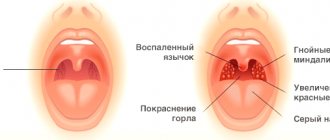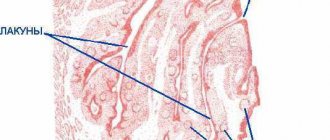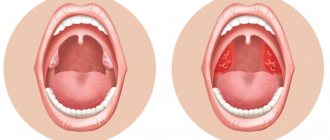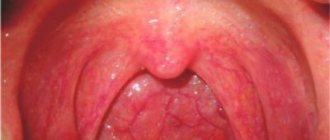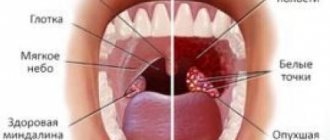Chronic tonsillitis is an inflammatory lesion of the palatine tonsils, which either subsides or worsens.
Author:
- Galkin Alexey Vladimirovich
ENT pathology expert
3.67 (Votes: 3)
Chronic tonsillitis is an inflammatory lesion of the palatine tonsils, which either subsides or worsens.
What is the role of the palatine tonsils?
Tonsils are organs consisting of lymphoid tissue that are located in the nasopharynx and perform the function of immune defense. They got their name because of their external resemblance to an almond, which is why anatomists began to use the name “almond.”
Lymphoid tissue in the pharynx is present not only in the palatine tonsil, but also in other structures:
- lingual and nasopharyngeal tonsil;
- lymphoid foci of the posterior pharyngeal wall.
The lymphoid tissue of the pharynx is an important part of the immune system, since on its surface contact of the body’s immune cells with the environment occurs. The information received by the immune cells in the lymphoid structures of the pharynx is transmitted to the next level of immune organs (thymus, bone marrow, lymph nodes) for the production of protective proteins (immunoglobulins). Subsequently, they neutralize pathogenic viruses, bacteria, fungi and protozoa that enter the body from the external environment.
With age, the role of the tonsils as immune organs is gradually lost. Lymphoid tissue is gradually replaced by connective tissue elements, so involution (reverse development) of organs begins. The nasopharyngeal tonsil is the first to undergo involution, later it spreads to the lingual and palatine tonsils. Therefore, in the elderly, the tonsillar tissue (tonsil) decreases to the size of a pea.
The palatine tonsil is the most complex in structure. It consists of a large number of channels - crypts (or lacunae). Some crypts look like a shallow, more or less straight tubule, others have greater depth, branch like a tree, and some crypts are interconnected. Often, where the crypt opens into the pharynx, there is a narrowing of the canal. This makes it difficult to clear it of its contents, against the background of which an inflammatory process develops.
The palatine tonsil is bounded by a capsule - a dense connective tissue membrane. Outside of it there is a layer of loose tissue - paratonsillar or peritonsillar tissue. With severe inflammation, the infection destroys the barrier of the capsule and goes beyond it, causing inflammation of this fiber. This condition is called paratonsillitis. It refers to a serious complication, which, if treated incorrectly or untimely, can have serious consequences, such as the development of a purulent focus in the soft tissues of the neck (peritonsillar abscess, phlegmon of the neck), sepsis, and damage to internal organs. Therefore, it is necessary to start treatment as early as possible.
Causes of development of chronic tonsillitis
The development of chronic tonsillitis is possible according to 2 scenarios:
- as a result of tonsillitis (acute tonsillitis), which was incorrectly treated or the treatment was not completed;
- as a result of decreased immune defense and constant exposure to aggressive factors (this is a non-anginal option).
The following are aggressive stimuli:
- inhalation of tobacco smoke;
- poor nutrition;
- alcohol abuse;
- carious teeth;
- inflammatory processes in the paranasal sinuses (sinusitis, sinusitis, etc.);
- impaired nasal breathing that occurs when the nasal septum is deviated, polyps or hypertrophy of the inferior turbinates. Under such conditions, the oral mucosa dries out and the formation of immunoglobulin A is disrupted, which reduces the immune defense of the ENT organs.
However, exposure to the described factors alone is not enough for the development of chronic tonsillitis. Currently, it is considered the result of infection with pathogenic bacteria against the background of allergization (altered immune reactivity). Local changes in the lymphoid tissue after previous tonsillitis, as well as the factor of heredity, which manifests itself only under certain conditions of the internal and external environment, also have a role in this process.
Infection. The most common causes are streptococci and staphylococci. In this case, the maximum danger is posed by pyogenic streptococcus, which is called beta-hemolytic (belongs to group A). The risks associated with this pathogen are the likelihood of developing autoimmune diseases, i.e. when your own immune cells damage other cells in your body. This happens with glomerulonephritis, rheumatism, polyarthritis and other similar diseases.
Altered reactivity of the body (its allergization), which is characterized by excessive production of class E immunoglobulins. Under such conditions, the re-entry of antigens (for example, foreign bacterial proteins) triggers an allergic reaction that constantly maintains inflammation. This corresponds to the exacerbation phase of the pathological process.
It has been proven that the likelihood of chronic tonsillitis in people whose first- or second-degree relatives suffered from this disease is much higher than in other people. This is due to the peculiarities of the anatomy of the tonsillar crypts and immune status (tendency to an allergic response).
Complications
Chronic tonsillitis transforms the palatine tonsils from a protective organ into a focus for the accumulation of pathogenic microflora and their waste products. The infection does not sit still and spreads through the bloodstream throughout the body, affecting other human organs and systems. The disease hits the heart, kidneys and joints especially hard and can lead to myocarditis, glomerulonephritis, rheumatism, etc.
Chronic tonsillitis causes paratonsillar complications and leads to inflammation of the tissues around the tonsils - paratonsillar abscess, phlegmon, lymphadenitis.
Chronic tonsillitis is dangerous during pregnancy. It can lead to miscarriage or premature birth.
Hair loss, skin diseases, frequent headaches, dizziness, excessive sweating - all this is a consequence of chronic inflammation of the tonsils.
Clinical manifestations
The symptoms of tonsillitis depend on its form, which can be simple or toxic-allergic.
Signs of a simple form:
- Exacerbations no more than 1-2 times a year;
- Between exacerbations the general condition is not disturbed;
- There are no systemic manifestations of tonsillitis (no damage to other organs, no intoxication, general condition does not suffer);
- Local manifestations of the inflammatory process.
Signs of the toxic-allergic form are:
- Changes in the blood (they are detected by general clinical, biochemical and immunological analysis);
- Tonsillogenic intoxication;
- Symptoms of damage to internal organs (heart, blood vessels, kidneys, etc.), which are associated with the development of rheumatism, glomerulonephritis, vasculitis, septic endocarditis, etc.
Taking into account the severity of clinical symptoms, the toxic-allergic form can be grade 1 or 2. The differences between them are taken into account by B.S. Preobrazhensky’s classification.
When to see a doctor
Frequent cases of sore throat, prolonged recovery from respiratory infections, and persistent cough are reasons to immediately seek help from an otolaryngologist. The specialist will not only conduct a comprehensive diagnosis of the body, but will also tell you how to quickly and without consequences cure chronic tonsillitis. For additional consultations and examinations, you can contact the doctors of JSC "Medicine" (clinic of academician Roitber) in the central district of Moscow at the address: 2nd Tverskoy-Yamskaya lane, 10 (metro stations Mayakovskaya, Belorusskaya, Novoslobodskaya, Tverskaya, Chekhovskaya) . Experienced ENT doctors will offer an effective course of treatment for tonsillitis, taking into account the age and characteristics of the patient’s body. The selection of antibiotic drugs and physical therapy will be made based on the results of the examination and a history of diseases.
Classification B.S. Preobrazhensky
| Form of the inflammatory process | Distinctive manifestations |
| Simple (uncomplicated) form | Only local signs are present: Pus and dense plugs from it, closing the lumen of the lacunae, and the inflamed surface of the tonsils (they are loose, red, swollen). Inflamed edges of the arches of the palate (they are swollen, red, infiltrated). |
| Toxic-allergic tonsillitis 1st degree | Local manifestations of an uncomplicated form are superimposed by general symptoms of an allergic-toxic nature: Periodic low-grade fever (temperature readings up to 37.5°C). Tonsillogenic intoxication, present constantly or periodically - decreased performance, fatigue, poor appetite, general weakness, malaise, feeling of weakness throughout the body. Enlargement of the lymph nodes of the neck, their soreness. Periodically appearing joint pain. Changes in blood tests - increased leukocytes, accelerated ESR. |
| Toxic-allergic tonsillitis 2nd degree | Signs of the 1st degree are accompanied by severe manifestations of a toxic-allergic nature: Functional ECG changes. Heart pain. Heart rhythm disturbances. Long-lasting low-grade fever. Development of autoimmune complications of tonsillitis. |
Diagnosis of the disease
A diagnostic search for chronic tonsillitis is not only making a diagnosis, but also determining the form of the disease. Therefore, the examination is always comprehensive, which includes:
- Objective examination data (redness, swelling, injection of blood vessels on the tonsil mucosa, etc.);
- Survey – assessment of complaints, the history of their occurrence and other anamnestic information;
- Microbiological examination (seeding pathological secretions taken from lacunae on special media to determine the causative microbe, as well as its sensitivity to antimicrobial drugs);
- Laboratory tests (blood, urine);
- Instrumental examinations (ECG, ultrasound of the heart and lymph nodes).
Assessment of these parameters allows you to correctly determine the stage of the inflammatory process and optimally select treatment.
| Examination method | Signs | What does the examination give? |
| Collection of anamnesis and complaints | Pain and discomfort in the throat, sensation of a lump or foreign body, heart and joint pain, general weakness, malaise. Single or multiple exacerbations of tonsillitis throughout the year. | Allows you to suspect chronic tonsillitis and the stage of the process, and evaluate the effectiveness of the treatment. |
| Pharyngoscopy | Pus or purulent plugs on the surface of the tonsils (pathological secretion fills the lacunae). Redness, infiltration and swelling of the arches of the palate, their cicatricial fusion with the tonsil. | Confirms the diagnosis of chronic tonsillitis, but does not allow assessing the stage of the process. Allows you to evaluate the effectiveness of conservative treatment. |
| Bacteriological examination | Identification of the microorganism and its sensitivity to antibacterial therapy. | Allows you to identify the causative microorganism and select the necessary treatment. Assess the effectiveness of conservative treatment. |
| Laboratory diagnostics | Clinical blood test, biochemical blood test (urea, creatinine, ALT, AST), C-reactive protein, ASLO, rheumatoid factor, IgE, total blood IgA. | Allows you to determine the activity of inflammation, identify the risk of development or the presence of concomitant diseases (rheumatism, glomerulonephritis, polyarthritis, infective endocarditis, etc.) Helps choose treatment tactics, evaluate the effectiveness of treatment. |
| Functional diagnostics | ECG (electrocardiogram) Echo-CG (ultrasound of the heart) Ultrasound of the kidneys Ultrasound of the lymph nodes of the neck. | Helps determine the stage of chronic tonsillitis, identify the presence of associated diseases (rheumatism, glomerulonephritis, polyarthritis, infective endocarditis, etc.) Helps choose treatment tactics. |
Prevention
Prevention of chronic tonsillitis comes down to the following measures:
- avoid hypothermia;
- treat diseases of the oral cavity and acute inflammatory diseases of the nose and pharynx in a timely manner;
- visit the dentist not when you are sick, but once every six months;
- monitor oral hygiene;
- bring your nutrition closer to the correct one;
- avoid stressful situations;
- give up bad habits;
- strengthen your immune system: walk more often, play sports or do any physical activity;
- Protect your ENT organs if you work in “dirty” industries.
Treatment of chronic tonsillitis
Chronic tonsillitis is treated using both conservative and surgical methods.
Conservative methods are:
- antibiotics that are prescribed both locally (gargling) and systemically (tablet or injection forms);
- direct washing of lacunae and introduction of antibacterial and anti-inflammatory drugs into them;
- physiotherapeutic procedures (hallotherapy, magnetic laser treatment of lymph nodes, phonophoresis and ultraviolet irradiation of the palatine tonsils).
| Treatment method | Mechanism of action | Target |
| Irrigation of lacunae using a cannula | The lacunae are cleaned of pus, microorganisms, food debris, and epidermal plugs using a jet of antiseptic solution. In the future, an antibacterial and anti-inflammatory drug may be administered | Cleansing lacunae Bactericidal effect Anti-inflammatory effect |
| Washing lacunae using a vacuum nozzle | Due to the action of vacuum, the contents are removed from the lacunae. | Cleaning gaps |
| Magnetic laser therapy (MILTA) | The effect of a magnetic field and laser radiation on the area of inflammation. The microcirculation of the affected area improves, and the local protective properties of the mucous membrane are activated. | Anti-inflammatory effect Activation of local immunity |
| Phonophoresismedicines | The effect of drugs (antibacterial, anti-inflammatory) on the mucous membrane of the tonsils. Under the influence of ultrasound, drugs penetrate into the deep sections of the lacunae. | Anti-inflammatory effect Bactericidal effect |
| Ultraviolet radiation (UV) | Ultraviolet radiation has a bactericidal effect and activates local immunity of the mucous membrane. | Bactericidal effect Activation of local immunity |
Surgical treatment methods:
- Tonsillectomy – removal of the tonsils along with the capsule (instrumental and bloodless technique).
- Destruction of lymphoid tissue in the tonsil (radio wave ablation, cryodestruction).
- Cryptolysis (“soldering” of palatal lacunae).
| Method of therapy | Mechanism of action | Advantages | Indications |
| Tonsillectomy performed with traditional instruments (instrumental) | Isolation of the tonsil and its capsule is carried out with surgical instruments (loop, raspatory) | Speed of surgery | Previous treatment was ineffective. Beta-hemolytic streptococcus was detected. Toxic-allergic form of tonsillitis. |
| Tonsillectomy bloodless | The tonsil is released from the capsule using a laser, radio wave, cold plasma energy or other physical methods | Simultaneous dissection and coagulation of tissue. The intervention is bloodless | Previous treatment was ineffective. Beta-type hemolytic streptococcus was detected. Toxic-allergic form of tonsillitis. |
| Destruction (ablation) of the lymphoid elements of the tonsil | Radio waves, laser, high or low temperatures destroy most of the lymphoid structures of the tonsils | Can be carried out in a clinic setting | Previous treatment was ineffective Simple (catarrhal) form of tonsillitis |
| Cryptolysis | Destruction of the epithelial layer of lacunae due to physical methods of influence. Under such conditions, they stick together, so food particles and microorganisms do not penetrate there, i.e. inflammation cannot develop. | Can be carried out in outpatient settings | Previous treatment was ineffective Simple (catarrhal) form of tonsillitis |
Literature
- D.L. Yalymova, V.V. Vishnyakov, V.N. Talalaev, V.N. Kostyuk. Chronic tonsillitis: diagnosis, classification, treatment. Directory of a polyclinic doctor. 2014; 08: p. 29-31.
- Chronic tonsillitis. Directory of a polyclinic doctor. 2014; 09: p. 43.
- G.S. Maltseva. Chronic tonsillitis: current issues (clinical lecture). Consilium Medicum. 2011; 11: p. 32-38.
- A.I. Kryukov, Yu.V. Better. Sore throat and chronic tonsillitis: the problem of choosing an antibacterial drug in an outpatient setting. Directory of a polyclinic doctor. 2007; 04: p. 42-44.
- Instructions for use of the drug HEXORAL® solution.
Up to contents

